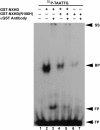NOBOX homeobox mutation causes premature ovarian failure
- PMID: 17701902
- PMCID: PMC1950834
- DOI: 10.1086/519496
NOBOX homeobox mutation causes premature ovarian failure
Abstract
NOBOX (newborn ovary homeobox gene) is an oocyte-specific homeobox gene that plays a critical role in early folliculogenesis and represents a candidate gene for nonsyndromic ovarian failure. We investigated whether mutations in the NOBOX gene cause premature ovarian failure (POF). We sequenced the NOBOX gene in 96 white women with POF and discovered seven known single-nucleotide polymorphisms and four novel variations, two of which, p.Arg355His and p.Arg360Gln, cause missense mutations in the homeobox domain. Electrophoretic mobility shift assay (EMSA) confirmed that the missense mutation, p.Arg355His, disrupted NOBOX homeodomain binding to NOBOX DNA-binding element (NBE) and had a dominant negative effect on the binding of wild-type NOBOX to DNA. Our findings demonstrate that NOBOX mutations can cause POF.
Figures



Similar articles
-
Mutation analysis of NOBOX homeodomain in Chinese women with premature ovarian failure.Fertil Steril. 2009 Apr;91(4 Suppl):1507-9. doi: 10.1016/j.fertnstert.2008.08.020. Epub 2008 Oct 17. Fertil Steril. 2009. PMID: 18930203
-
Novel NOBOX loss-of-function mutations account for 6.2% of cases in a large primary ovarian insufficiency cohort.Hum Mutat. 2011 Oct;32(10):1108-13. doi: 10.1002/humu.21543. Epub 2011 Sep 9. Hum Mutat. 2011. PMID: 21837770
-
Mutational analysis of the homeobox region of the human NOBOX gene in Japanese women who exhibit premature ovarian failure.Fertil Steril. 2005 Jun;83(6):1843-4. doi: 10.1016/j.fertnstert.2004.12.031. Fertil Steril. 2005. PMID: 15950662
-
Candidate genes for premature ovarian failure.Curr Med Chem. 2007;14(3):353-7. doi: 10.2174/092986707779941087. Curr Med Chem. 2007. PMID: 17305537 Review.
-
Transcriptional regulation of early oogenesis: in search of masters.Hum Reprod Update. 2006 Jan-Feb;12(1):65-76. doi: 10.1093/humupd/dmi033. Epub 2005 Sep 2. Hum Reprod Update. 2006. PMID: 16143663 Review.
Cited by
-
Premature ovarian insufficiency: a review on the role of tobacco smoke, its clinical harm, and treatment.J Ovarian Res. 2024 Jan 9;17(1):8. doi: 10.1186/s13048-023-01330-y. J Ovarian Res. 2024. PMID: 38191456 Free PMC article. Review.
-
Next-generation sequencing of 500 POI patients identified novel responsible monogenic and oligogenic variants.J Ovarian Res. 2023 Feb 15;16(1):39. doi: 10.1186/s13048-023-01104-6. J Ovarian Res. 2023. PMID: 36793102 Free PMC article.
-
Management of a Girl With Delayed Puberty and Elevated Gonadotropins.J Endocr Soc. 2022 Jul 8;6(9):bvac108. doi: 10.1210/jendso/bvac108. eCollection 2022 Sep 1. J Endocr Soc. 2022. PMID: 35935072 Free PMC article.
-
Exome Sequencing of a Primary Ovarian Insufficiency Cohort Reveals Common Molecular Etiologies for a Spectrum of Disease.J Clin Endocrinol Metab. 2019 Aug 1;104(8):3049-3067. doi: 10.1210/jc.2019-00248. J Clin Endocrinol Metab. 2019. PMID: 31042289 Free PMC article.
-
Genetics of human female infertility†.Biol Reprod. 2019 Sep 1;101(3):549-566. doi: 10.1093/biolre/ioz084. Biol Reprod. 2019. PMID: 31077289 Free PMC article. Review.
References
Web Resources
-
- Ensembl, http://www.ensembl.org/(for NOBOX [accession number ENST00000389325])
-
- dbSNP, http://www.ncbi.nlm.nih.gov/SNP/ (for IDs shown in table 2)
-
- GenBank, http://www.ncbi.nlm.nih.gov/Genbank/ (for NOBOX [accession number NM_001080413])
-
- NCBI Protein Database, http://www.ncbi.nlm.nih.gov/sites/entrez?db=protein&cmd=search&term= (accession number XP_001134420)
-
- Online Mendelian Inheritance in Man (OMIM), http://www.ncbi.nim.nih.gov/Omim (for POF, NOBOX, FMR1, POF1B, FSHR, FOXL2, BMP15, GDF9, and POU5F1)
References
-
- Coulam CB, Adamson SC, Annegers JF (1986) Incidence of premature ovarian failure. Obstet Gynecol 67:604–606 - PubMed
-
- Simpson JL, Rajkovic A (2004) Germ cell failure and ovarian resistance: human genes and disorders. In: Leung PCK, Adashi EY (eds) The ovary, 2nd ed. Academic Press, San Diego, pp 541–557
Publication types
MeSH terms
Substances
Associated data
- Actions
- Actions
Grants and funding
LinkOut - more resources
Full Text Sources
Medical
Molecular Biology Databases
Research Materials

